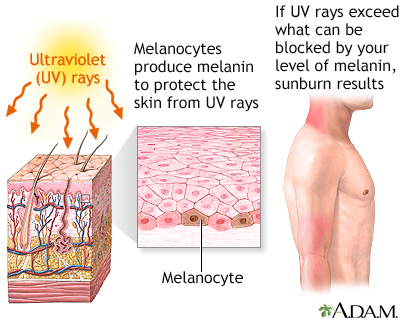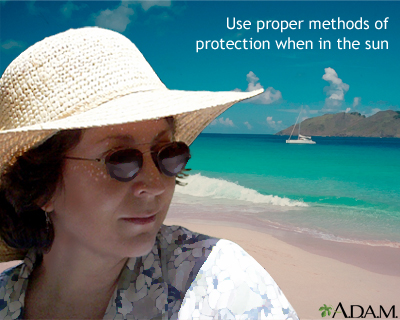A sunburn is reddening of the skin that occurs after you are overexposed to the sun or other ultraviolet light.

Considerations
The first signs of a sunburn may not appear for a few hours. The full effect to your skin may not appear for 24 hours or longer. Possible symptoms include:
- Red, tender skin that is warm to the touch
- Blisters that develop hours to days later
- Severe reactions (sometimes called sun poisoning), including fever, chills, nausea, or rash
- Skin peeling on sunburned areas several days after the sunburn
Symptoms of sunburn are usually temporary. But the damage to skin cells is often permanent, which can have serious long-term effects. These include skin cancer and early aging of the skin. By the time the skin starts to become painful and red, the damage has been done. Pain is worst between 6 to 48 hours after sun exposure.
Home Care
If you do get a sunburn:
- Take a cool shower or bath or place clean wet, cool wash cloths on the burn.
- DO NOT use products that contain benzocaine or lidocaine. These can cause allergies in some people and make the burn worse.
- If there are blisters, dry bandages may help prevent infection.
- If your skin is not blistering, moisturizing cream may be applied to relieve discomfort. DO NOT use butter, petroleum jelly (Vaseline), or other oil-based products. These can block pores so that heat and sweat cannot escape, which can lead to infection. DO NOT pick at or peel away the top part of the blisters.
- Creams with vitamins C and E may help limit damage to skin cells.
- Over-the-counter medicines, such as ibuprofen or acetaminophen, help to relieve pain from sunburn. DO NOT give aspirin to children.
- Cortisone creams may help reduce inflammation.
- Loose cotton clothing should be worn.
- Drink lots of water.
Ways to prevent sunburn include:
- Use a broad-spectrum sunscreen of SPF 30 or higher. A broad-spectrum sunscreen protects from both UVB and UVA rays.
- Apply a generous amount of sunscreen to fully cover exposed skin. Reapply sunscreen every 2 hours or as often as the label says.
- Reapply sunscreen after swimming or sweating and even when it is cloudy.
- Use a lip balm with sunscreen.
- Wear a hat with a wide brim and other protective clothing. Light-colored clothing reflects the sun most effectively.
- Stay out of the sun during hours when the sun's rays are strongest between 10 a.m. and 4 p.m.
- Wear sunglasses with UV protection.

When to Contact a Medical Professional
Call your health care provider right away if you have a fever with sunburn. Also call if there are signs of shock, heat exhaustion, dehydration, or other serious reactions. These signs include:
- Feeling faint or dizzy
- Rapid pulse or rapid breathing
- Extreme thirst, no urine output, or sunken eyes
- Pale, clammy, or cool skin
- Nausea, fever, chills, or rash
- Your eyes hurt and are sensitive to light
- Severe, painful blisters
What to Expect at Your Office Visit
Your provider will perform a physical exam and look at your skin. You may be asked about your medical history and current symptoms, including:
- When did the sunburn occur?
- How often do you get sunburn?
- Do you have blisters?
- How much of the body was sunburned?
- What medicines do you take?
- Do you use a sunblock or sunscreen? What type? How strong?
- What other symptoms do you have?
Alternative Names
Solar erythema; Burn from the sun
References
American Academy of Dermatology website. Sunscreen FAQs. www.aad.org/public/everyday-care/sun-protection/sunscreen-patients/sunscreen-faqs. Accessed June 20, 2023.
Dinulos JGH. Light-related diseases and disorders of pigmentation. In: Dinulos JGH, ed. Habif's Clinical Dermatology. 7th ed. Philadelphia, PA: Elsevier; 2021:chap 19.
Sherman KS. Sunburn. In: Kellerman RD, Rakel DP, Heidelbaugh JJ, Lee EM, eds. Conn's Current Therapy 2023. Philadelphia, PA: Elsevier; 2023:1125-1126.
Review Date 6/7/2023
Updated by: Elika Hoss, MD, Assistant Professor of Dermatology, Mayo Clinic, Scottsdale, AZ. Also reviewed by David C. Dugdale, MD, Medical Director, Brenda Conaway, Editorial Director, and the A.D.A.M. Editorial team.








 Watch this video about:
Watch this video about:







